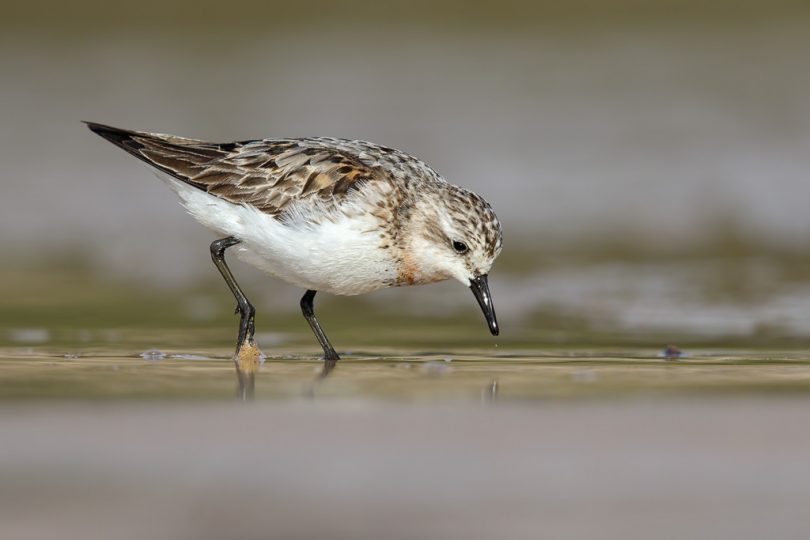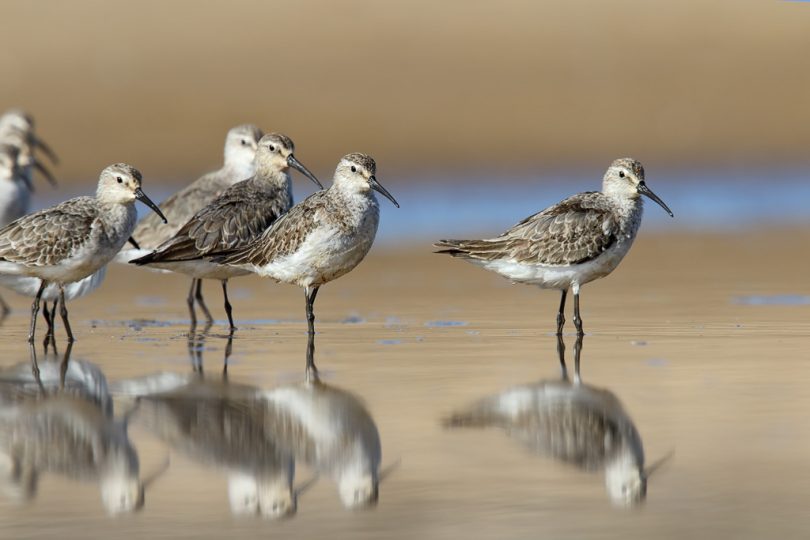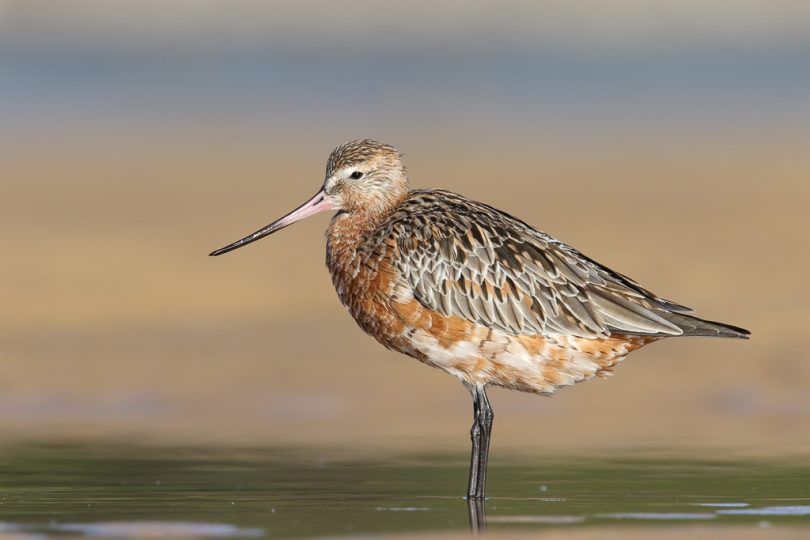
Bar-tailed Godwit, Merimbula. Photo: Leo Berzins.
Local birdwatchers have welcomed news that parts of the Chinese coastline along the Yellow Sea have received World Heritage listing.
“This is great news for the migratory shorebirds of the NSW Far South Coast,” explains Leo Berzins form Far South Coast Birdwatchers.
“The Yellow Sea is at the centre of the East Asian–Australasian Flyway, a migration ‘super highway’ that sustains many migratory shorebirds on their annual journey to breeding grounds in Siberia and Alaska.
“Birds such as the critically endangered Far Eastern Curlew rely on a few weeks stopover on the rich mudflats of the Yellow Sea to rebuild their reserves so they can complete their marathon journeys. The extent of these vital mudflats has been declining over the past two decades due to coastal reclamation and development.”
According to Birdlife Australia, the Australian Government has played a crucial role in securing the decision from the World Heritage Committee.
The listing will help protect remaining areas of coastal wetland habitat after decades of reclamation for industrial land.
“China has shown real global leadership by announcing a moratorium on coastal reclamation and securing World Heritage listing for the Yellow Sea ecosystem,” says BirdLife Australia CEO Paul Sullivan.
“The Australian Government should be congratulated for playing a significant leadership role in ensuring this World Heritage listing; reflecting the global importance of this site for our migratory shorebirds and the strength of China’s nomination.
“We hope the decision will also help to expedite the inscription of other important sites in South Korea next year, China in 2022 and, hopefully, North Korea.”

Eastern Curlew, Merimbula. Photo: Leo Berzins.
Mr Sullivan says Australia has bilateral agreements in place with China, the Republic of Korea and Japan to protect migratory shorebirds.
“The decision in Baku is also significant because China will host the 15th Conference of the Parties of the United Nation’s Convention for Biological Diversity in 2020.”
“BirdLife International and its country partners are calling on all governments to embrace a ‘New Deal for Nature’ with ambitious targets at the meeting.
“It’s our last chance to save nature. A recent UN Global Assessment reported that business as usual will result in the loss of a million species, as well as food and water shortages.”
The East Asian–Australasian Flyway supports the world’s greatest diversity and overall numbers of migratory birds. It links the bird populations of more than 22 countries, with Australia and the Far South Coast of NSW being the non-breeding destination of many species.

Red-necked Stint, Mogareeka. Photo: Leo Berzins.
It’s an extraordinary story of strength, natural instinct and survival that happens on the region’s doorstep and one that Far South Coast Birdwatchers delight in.
“Some five million migratory shorebirds spend the warmer months of the year on the productive shores of Australia and New Zealand,” Leo Berzins says.
“Come April and May they sense the shift toward cooler days and prepare for their long migration which takes them up the eastern seaboard of Asia to their breeding grounds in Alaska and Siberia.
“This preparation involves eating to the point where they almost double their body weight. This is literally the fuel that will take them the thousands of kilometres they need to go to reach their breeding grounds.
“Above the Arctic Circle, for about ten months of the year, the ground of Siberia and Alaska is frozen solid. But the 24-hour summer sun brings with it a brief thawing of the permafrost, resulting in the formation pools of meltwater teeming with insect life.
“The shorebirds arrive into this abundance of food and light, and in the brief six to eight weeks of the arctic summer they mate, lay eggs and hatch their young.
“On the way to and from their breeding grounds, the birds may make stopovers to rest and refuel. Of all the places where the birds take their rest, the most important is the Yellow Sea. Bordered by North and South Korea and China, this is a bottleneck of fertile shorebird habitat through which thousands of shorebirds will pass annually on their migrations.”

Curlew Sandpipers, Mogareeka. Photo: Leo Berzins.
Migratory shorebirds that are commonly seen locally include Far Eastern Curlew, Bar-tailed Godwit, Red-necked Stint, Sharp-tailed Sandpiper and Curlew Sandpiper.
Mr Berzins says the Far Eastern Curlew is the largest of all Australia’s migratory shorebirds and it is listed as Critically Endangered.
“Long-term monitoring by BirdLife Australia has shown that the number of Far Eastern Curlews visiting Australia has crashed by more than 80 per cent in the last 30 years.”
“This precipitous decline has been largely attributed to the changes on the coast of the Yellow Sea.
“Local birdwatchers have also noticed this decline. Curlews can still be found at Wallaga Lake, Merimbula Lake and Eden’s Lake Curalo but not in the same numbers as they were a decade or two ago.”
Another species now listed as Critically Endangered is the Curlew Sandpiper.

Bar-tailed Godwit, Merimbula.Photo: Leo Berzins.
“They have also become harder to find locally but in a good year there are still small numbers at such locations as Wallaga Lake and Wallagoot Lake,” he says.
“Some species seem to be in less trouble. For instance Merimbula’s most abundant shorebird, the Bar-tailed Godwit still numbers about 140 individuals over summer and 30-40 of these remain over winter.
“Our smallest migratory shorebird, the Red-necked Stint also seems to be surviving reasonably well. These tiny birds can be regularly seen over summer in such locations as Wallaga Lake, Mogareeka and Wallagoot Lake.
“Hopefully, the protection of the Yellow Sea coastline will at least slow the decline in numbers of our endangered shorebirds and prevent more species from joining that list.
“We look forward to seeing these amazing birds on the NSW Far South Coast for many years to come.”
Far South Coast Birdwatchers meet regularly, a dynamic group that always welcomes interested people, connect via their website.


